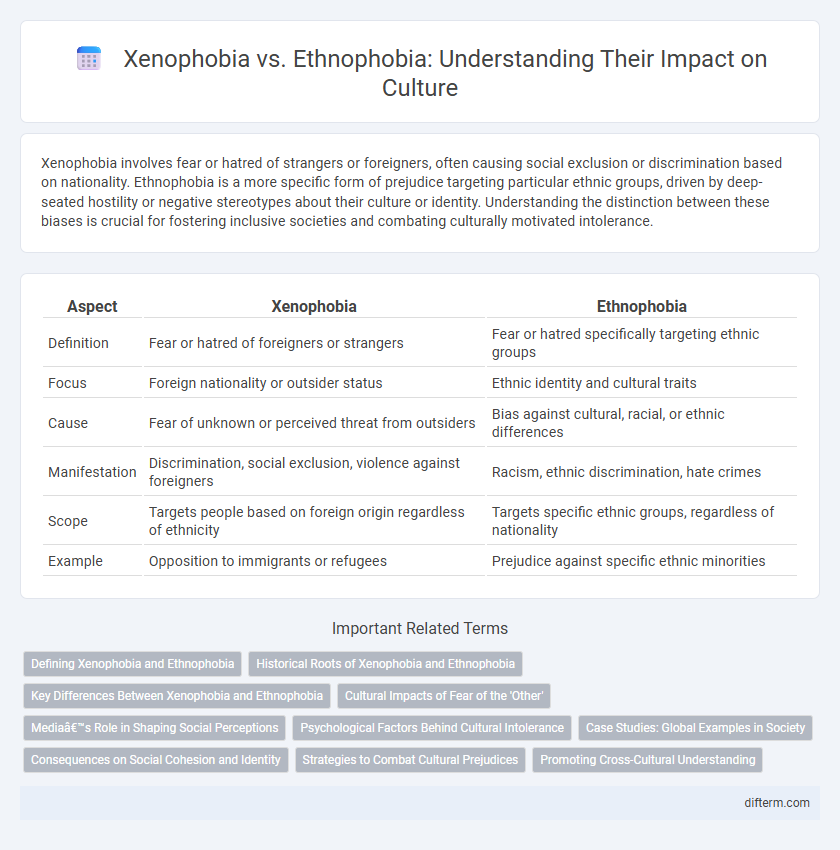Xenophobia involves fear or hatred of strangers or foreigners, often causing social exclusion or discrimination based on nationality. Ethnophobia is a more specific form of prejudice targeting particular ethnic groups, driven by deep-seated hostility or negative stereotypes about their culture or identity. Understanding the distinction between these biases is crucial for fostering inclusive societies and combating culturally motivated intolerance.
Table of Comparison
| Aspect | Xenophobia | Ethnophobia |
|---|---|---|
| Definition | Fear or hatred of foreigners or strangers | Fear or hatred specifically targeting ethnic groups |
| Focus | Foreign nationality or outsider status | Ethnic identity and cultural traits |
| Cause | Fear of unknown or perceived threat from outsiders | Bias against cultural, racial, or ethnic differences |
| Manifestation | Discrimination, social exclusion, violence against foreigners | Racism, ethnic discrimination, hate crimes |
| Scope | Targets people based on foreign origin regardless of ethnicity | Targets specific ethnic groups, regardless of nationality |
| Example | Opposition to immigrants or refugees | Prejudice against specific ethnic minorities |
Defining Xenophobia and Ethnophobia
Xenophobia is the fear or hatred of strangers or foreigners, often manifesting in discriminatory attitudes and behaviors toward people perceived as outsiders based on nationality or ethnicity. Ethnophobia specifically refers to hostility toward particular ethnic groups, rooted in prejudice against cultural, racial, or ancestral differences. Both xenophobia and ethnophobia contribute to social divisions but differ in that xenophobia centers on fear of foreigners while ethnophobia targets ethnic identities within or across societies.
Historical Roots of Xenophobia and Ethnophobia
Xenophobia and ethnophobia have deep historical roots tied to social identity and territorial conflicts, often emerging from cultural misunderstandings and perceived threats to group cohesion. Xenophobia typically arises from fear or hatred of outsiders or foreigners, while ethnophobia specifically targets ethnic groups based on prejudice and stereotypes. Historical episodes such as colonialism, migration crises, and nationalist movements have exacerbated these fears, embedding them into societal structures and collective memory.
Key Differences Between Xenophobia and Ethnophobia
Xenophobia is the fear or hatred of foreigners and strangers, often manifesting as hostility toward individuals from different countries. Ethnophobia specifically targets ethnic groups, involving prejudice and discrimination based on cultural, racial, or ethnic identity. While xenophobia centers on unfamiliarity and perceived outsider status, ethnophobia is driven by deep-seated biases against particular ethnic communities.
Cultural Impacts of Fear of the 'Other'
Xenophobia and ethnophobia fuel deep-seated cultural divisions by fostering fear and mistrust of the 'Other,' leading to social exclusion and erosion of community cohesion. These biases disrupt multicultural dialogue, diminish cultural exchange, and reinforce stereotypes that hinder cultural understanding and integration. The pervasive impact often results in cultural homogenization, where dominant groups suppress minority identities, undermining cultural diversity and social harmony.
Media’s Role in Shaping Social Perceptions
Media plays a critical role in shaping social perceptions by influencing public understanding of xenophobia and ethnophobia through selective framing and narrative emphasis. The portrayal of ethnic groups in news outlets and entertainment often reinforces stereotypes or fosters empathy, directly impacting societal attitudes and behaviors. Strategic media representation can either perpetuate fear and division or promote inclusivity and cultural awareness.
Psychological Factors Behind Cultural Intolerance
Psychological factors driving cultural intolerance include fear of the unknown, identity threats, and in-group bias, which manifest in xenophobia and ethnophobia. Xenophobia targets foreigners or perceived outsiders, while ethnophobia specifically involves hostility toward particular ethnic groups. Cognitive rigidity and social conditioning reinforce these prejudices, perpetuating cycles of discrimination and exclusion within societies.
Case Studies: Global Examples in Society
Xenophobia and ethnophobia manifest distinctly across global societies, with xenophobia often targeting foreigners regardless of ethnicity, as seen in European anti-immigrant movements. Ethnophobia, rooted in ethnic hatred, drives conflicts such as the Rwandan Genocide, where ethnic Tutsi were persecuted by Hutu extremists. Case studies reveal xenophobia frequently arises from economic anxieties, while ethnophobia is deeply tied to historical grievances and identity politics.
Consequences on Social Cohesion and Identity
Xenophobia fosters social fragmentation by promoting fear and distrust of outsiders, weakening social cohesion and undermining a collective identity. Ethnophobia intensifies intra-group conflicts and perpetuates cycles of discrimination, destabilizing multicultural harmony and eroding shared cultural values. Both phenomena disrupt communal stability and hinder efforts toward inclusive societal integration.
Strategies to Combat Cultural Prejudices
Implementing comprehensive educational programs that promote cultural awareness can effectively reduce xenophobia and ethnophobia by fostering empathy and understanding among diverse groups. Encouraging intercultural dialogue and collaboration in community initiatives helps dismantle stereotypes and build inclusive environments. Policy measures that protect minority rights and promote equality also play a critical role in combating cultural prejudices sustainably.
Promoting Cross-Cultural Understanding
Promoting cross-cultural understanding requires addressing both xenophobia and ethnophobia by fostering empathy and respect for diverse cultural identities. Educational programs and intercultural dialogues play a crucial role in dismantling stereotypes and encouraging inclusive attitudes among different ethnic groups. Collaborative community initiatives enhance social cohesion and contribute to a culture of mutual appreciation and peaceful coexistence.
xenophobia vs ethnophobia Infographic

 difterm.com
difterm.com